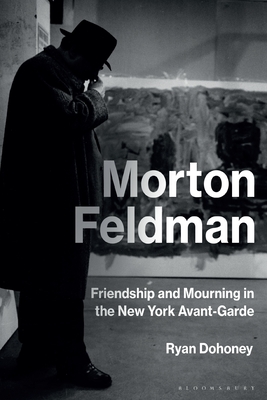Friendship and Mourning in the New York Avant-Garde
Ryan Dohoney
Bloomsbury ($29.95)
by Patrick James Dunagan
Ryan Dohoney’s Morton Feldman: Friendship and Mourning in the New York Avant-Garde explores how the composer’s work was both derived from and sustained by his early friendships in the 1950s Abstract Expressionist scene in New York City. Dahoney gives special emphasis to the impact of the tragic early death of poet Frank O’Hara in 1966 and the falling out experienced between Feldman and painter Philip Guston in 1970, but he also touches upon less celebrated artistic affiliations of Feldman’s, such as with dancer Merle Marsicano. There’s little gossip: the author largely avoids sentimental clichés or otherwise overt pandering to emotional cues and dramatic scenes. After all, even as “Feldman relished intimate details and preferred performances between friends,” he wasn’t known publicly or privately for expressing his emotions (aside from existential despair over his art), and his minimalist compositions are anything but effusive in terms of displaying personal feeling. Yet Dohoney succinctly demonstrates that friendship indeed lies at the heart of several of Feldman’s paramount pieces of music.
Pages of Feldman’s scores are reproduced as his own writings and talks are cited alongside critical commentary. Works by the other artists are likewise discussed; Dohoney draws upon outside criticism for useful comparisons with Feldman’s work. For instance, two Feldman compositions, Three Clarinets, Cello, and Piano and For Frank O’Hara were each at one time entitled In Memory of My Feelings, a well-known longer poem of O’Hara’s;
As Nick Shelby notes, the final sections of the poem are marked by an attempt to reconfigure a sense of self out of the collage of images and experiences. This corresponds to Feldman’s own creation of music, which attempts to get itself together, to build up a coherent sense of progression or movement from fragmentary gestures that can seem aimless or inchoate.
Dohoney is a sympathetic and well-informed reader/listener. He recognizes “the precariousness of Feldman’s social ties” and brings them to the fore while noting that “friendship is not always a positive force—it is sometimes an underdetermined name for remarkably varied attachments.” What once sustained a friendship understandably undergoes transformation over several years. With Guston, the ties the two shared during the heyday of 1950s New York proved unsustainable after Guston’s turn towards (crude) figuration as he ceased to resist the figure’s emergence in his work. His struggle with abstraction had moved forward to another stage. At Guston’s infamous 1970 Marlborough gallery show, full of cartoon-like images of heads, coats, shoes, rocks, and other debris of life, Feldman failed to support the change of direction and the two were never in direct conversation again.
The reader can’t help but feel melancholy that the days of spending hours hanging around each other in Guston’s studio, followed by deli sandwiches or long dinners at Chinese restaurants while bantering about their inner struggles, were over. Dohoney describes how at Marlborough, Guston “needed Morty’s opinion instantly, to feel Morty’s affection and understanding to keep going. And he didn’t get it in time. The ‘truth of abstraction’ proved stronger for Feldman than friendship itself. Therein lies the tragedy.” They remained silently in dialogue throughout the years, however; Guston painted images recollective of Feldman into pieces from the ’70s, just as Feldman composed For Philip Guston in tribute to his old friend after Guston’s passing. Feldman also honored one of Guston’s final requests: that he read the Kaddish over his grave.
For Dohoney, there’s no doubt of friendship having been the motivating influence upon Feldman. More so, he’s adamant that his survey of Feldman’s work demonstrates just how vital friendship was within the wider context of the era: “Feldman’s laments for his community provide clear evidence that friendship in fact produced New York School modernism.” Whether all readers agree or not, Dohoney’s argument is quite persuasive, especially when it comes to the heart of his study: engaging with the composer’s work. He suggests that “Feldman’s music encourages us to hear and feel this loss of coterie as an afterimage—something vanished yet affectively present.” Indeed, Feldman always kept on going with the work even when the impetus of friendship that once sustained it had moved on. Like all great artists, he had no choice.
Click here to purchase this book at your local independent bookstore
Rain Taxi Online Edition Fall 2022 | © Rain Taxi, Inc. 2022


